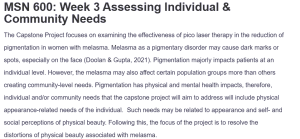MSN 600: Week 3 Assessing Individual & Community Needs
The Capstone Project focuses on examining the effectiveness of pico laser therapy in the reduction of pigmentation in women with melasma. Melasma as a pigmentary disorder may cause dark marks or spots, especially on the face (Doolan & Gupta, 2021). Pigmentation majorly impacts patients at an individual level. However, the melasma may also affect certain population groups more than others creating community-level needs. Pigmentation has physical and mental health impacts, therefore, individual and/or community needs that the capstone project will aim to address will include physical appearance-related needs of the individual. Such needs may be related to appearance and self- and social perceptions of physical beauty. Following this, the focus of the project is to resolve the distortions of physical beauty associated with melasma.
Secondly, patients with pigmentary disorders have significant psychological needs. Pigmentation related to melasma is linked to the development of mental health conditions such as depression, anxiety disorder, and somatic symptom disorder (Dabas et al., 2020). It is also a cause of self-esteem and a low quality of life (Platsidaki et al., 2023). Thirdly at the individual level, access to care related to the affordability of treatment modalities such as laser therapy may create financial needs. Therefore, such accessibility-related needs must be considered during the development of the project.
At the community level, education needs are major as most people may not understand the causes of pigmentation especially in individuals with melasma. Education can improve the utilization of care and address other cultural views of pigmentation to ensure equitable access to available care. Consistently, the research findings of this project will resolve these physical, mental, and educational needs at the individual and community levels. Evidently, laser therapies have been found to be safe and effective in the management of melasma (Feng et al., 2023). The project will justify the use of pico laser therapy as an effective and safer alternative to first-line treatments such as topical formulations such as hydroquinone while reducing the risk of recurrence. At the same time, patients will have access to mental and psychological support and promote preventative care
References
Dabas, G., Vinay, K., Parsad, D., Kumar, A., & Kumaran, M. S. (2020). Psychological disturbances in patients with pigmentary disorders: a cross-sectional study. Journal of the European Academy of Dermatology and Venereology, 34(2), 392–399. https://doi.org/10.1111/JDV.15987
Doolan, B. J., & Gupta, M. (2021). Melasma. Australian Journal of General Practice, 50(12), 880–885. https://search.informit.org/doi/abs/10.3316/informit.188969926936982
Feng, J., Shen, S., Song, X., & Xiang, W. (2023). Efficacy and safety of picosecond laser for the treatment of melasma: a systematic review and meta-analysis. Lasers in Medical Science, 38(1), 1–7. https://doi.org/10.1007/S10103-023-03744-Y/
Platsidaki, E., Efstathiou, V., Markantoni, V., Kouris, A., Kontochristopoulos, G., Nikolaidou, E., Rigopoulos, D., Stratigos, A., & Gregoriou, S. (2023). Self-Esteem, Depression, Anxiety and Quality of Life in Patients with Melasma Living in a Sunny Mediterranean Area: Results from a Prospective Cross-Sectional Study. Dermatology and Therapy, 13(5), 1127–1136. https://doi.org/10.1007/S13555-023-00915-1/
ORDER A PLAGIARISM-FREE PAPER HERE
We’ll write everything from scratch
Question
Week 3: Discussion Question – Assessing Individual & Community Needs
Discussion Prompt
- Discuss the individual and/or community needs as it relates to the reason for your capstone research inquiry. Why do you believe your research inquiry/findings will address the identified needs that prompted your inquiry?
MSN 600: Week 3 Assessing Individual & Community Needs
Expectations
- Length: A minimum of 275 words, not including references
- Citations: At least two high-level scholarly reference in APA from within the last 5 years


